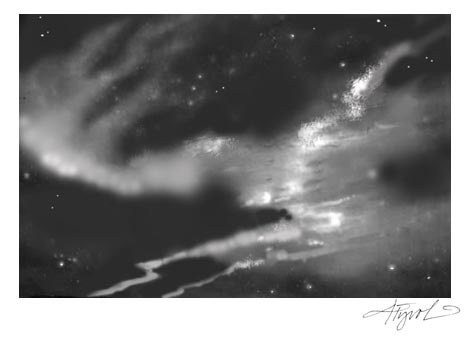
On October 8, 2013, friends Dan Russell and Charles Baldridge stood on the eastern shore of Lake Champlain and had what they later described as an awe-inspiring experience. For an hour and a half, the sky was lit up with columns of white light, some of them tinged with red and green. This was the Aurora Borealis making an unusual appearance over northern New England.
Russell remembered having goose bumps for most of the event, while Baldridge remembered wanting to call everyone he knew. “It was really exciting.”
The Aurora Borealis, also known as the Northern Lights, results from a string of interactions that begin with storms on the sun’s surface. These solar storms, which increase in intensity over an eleven-year cycle, emit charged particles into the solar system. When this “solar wind” collides with the Earth’s magnetosphere (the area around our planet that is dominated by the Earth’s magnetic field), some of the charged particles get caught in the Earth’s magnetic lines. Their energy becomes stored in the near-Earth space environment.
The result is a build up of energy that, sooner or later, is going to have to let go. Kristina Lynch, a professor of physics and astronomy at Dartmouth College, compared it to a rubber band expanding. Eventually, the rubber band snaps back and charged particles rain down into the Earth’s upper atmosphere.
That’s when the light show begins. As particles collide with high altitude oxygen, they create red light. Collisions with lower altitude oxygen create green or yellowish light, and those with nitrogen usually result in blue light.
The shapes of auroras also vary from vertical columns stretching up from the horizon, to swirls of color resembling a vortex, to thin strips of seemingly endless light. The photographs that Russell took on October 8 captured a band of emerald green stretching horizontally over Lake Champlain, with a tall and broad column of magenta hovering above it.
The most common view of this phenomenon, however, is a more muted white band of light. Professor Lynch described noticing one such diffuse white light source on a winter evening in Hanover, New Hampshire. It would have been easy to dismiss the light as having a terrestrial source, but she knew better.
So how do you catch an Aurora Borealis display? Go north. Your chances improve the closer you get to the poles. During a typical year, the ideal location is around 65 degrees latitude, i.e. central Alaska, Iceland, northern Sweden.
If a trip to Scandinavia is not in the vacation budget, the good news is that the sun is currently at the peak of its eleven-year storm cycle, which means that aurora activity is more intense right now. This is also a period when magnetic lines waver and particle-atmosphere collisions occur farther south. During strong auroral events, the Aurora Borealis has been seen as far south as Texas.
To better your chances, choose a night with a clear, moonless sky, and find a location free of artificial light. Lynch also recommended waiting at least fifteen minutes for your eyes to adjust to the dark, so that you’ll be better able to discern muted colors.
Technology may also help you catch the Aurora Borealis. There are many on-line resources, both from government sites (see for example this link from NOAA) and aurora fan sites. (Russell’s Twitter feed alerted him to the October 8 display.)
A simple digital camera is a useful tool for aurora viewing, allowing you to capture subtle colors that you might not see with the naked eye. However, photographs only convey so much. “You can talk about it. You can look at the pictures,” said Russell. However, he noted that nothing equals the actual experience. Even Lynch, who has seen the phenomenon many times in her work in Alaska, remains deeply affected by aurora viewings. The first time she saw an arc of white light from horizon to horizon, she said, was the first time she had a physical, not just intellectual, perception of the Earth as a globe. “It’s a privilege to spend your life trying to quantify something that beautiful.”

